Navigating through a cluttered parking lot isn’t just a challenge; it’s a potential hazard. With the increasing number of vehicles and pedestrians sharing these spaces, the need for effective parking lot signage solutions has never been more critical.
Proper
parking lot signage installation is an investment in the safety and security of your property. Not only does it contribute to a well-organized traffic management system but with well-designed and strategically placed signage, commercial property owners can reduce potential liability claims.
Parking lot signage is vital for accessibility, ease of use, and curb appeal. With clear and visible signs, commercial property owners and managers can ensure smooth traffic flow and provide a safe environment for drivers and pedestrians. All signage, ground markings, and safety measures added to parking lots also require consistent care and maintenance to ensure longevity and ongoing safety.
Parking lot signage should be manufactured with robust materials and reflective features that can withstand harsh weather conditions without needing frequent replacement.
This blog post dives into how strategic placement of signage can significantly enhance traffic flow, prevent accidents, and improve overall safety, particularly benefiting property managers and business owners.

The Role of Parking Lot Signage in Traffic Flow Management
-
Organizing Traffic Movement:
Parking lot signage directs drivers and pedestrians and better organizes the flow of traffic. This can reduce confusion, traffic congestion, and the potential for accidents. Regular and new users of the property will have a better experience with clear directions.
Directional and speed limit signs guide drivers, reduce congestion, and create a safer parking lot for all users. Stop signs, yield signs, entry, and exit signs present a more efficient and quicker flow of traffic. By guiding drivers on appropriate speeds and directions, these signs contribute to a steady flow of traffic, even during peak hours.
Navigating a parking lot can be confusing, especially for unfamiliar visitors. Strategically placed signs in a parking lot help lower the potential for confusion for both drivers and pedestrians when navigating the property. Similar to regular roads, directional signage for driving, parking, crosswalks, and areas of no entry are needed.
Safety Benefits of Well-Placed Parking Lot Signage
Well-placed
parking lot safety signage protects both pedestrians and drivers from potential incidents. Signs depicting crosswalks, pedestrian zones, and speed limits enhance user safety and ease of use when navigating the parking lot.
Warning signs such as stop signs and no-entry signs are used to reduce the risk of accidents. Precise direction and navigational signage can inform parking lot users of safety measures and encourage sensible driving habits. Having these signs placed strategically throughout the property can support a safe environment.
-
Clear Entry and Exit Points:
Confusion at entry and exit points is a common cause of parking lot accidents. Well-placed signs that clearly mark these points help prevent collisions and ensure a smooth transition in and out of the parking area. This clarity reduces stress for drivers and enhances safety for everyone. Plus, customers will continue to support a business that creates a safe and hassle-free experience.
The Accessibility for Ontarians with Disabilities Act (AODA) is a provincial law regulating the development and enforcement of accessibility standards. Accessible parking spaces and pedestrian crossing signage must be visibility posted and enforced to protect both drivers and pedestrians with disabilities.
Types of Parking Lot Signage
Regulatory signs are the backbone of traffic control in parking lots. They express specific rules and regulations for both drivers and pedestrians when using the parking lot. These include “No Parking,” “Stop,” “Yield,” and other signs that dictate driver behaviour. They are crucial in maintaining order and ensuring compliance with traffic rules.
Directional signs that guide drivers to exits, parking spaces, time-limit drops, and designated parking are commonly accompanied by text and arrows for easy navigation. For larger parking lots, there may be one-way traffic lanes designed to better organize the movement of vehicles and pedestrians. These signs reduce confusion and help drivers find their way efficiently.
Warning signs inform drivers and pedestrians of potentially hazardous conditions. Signage depicting pedestrian crossings and maximum speed limits help to reduce accidents. Some parking lots may need special signage such as “Stop Ahead” signs, “Watch for Children” signs, and “Slippery When Wet” to mitigate risks and ensure safe driving practices.
Informational signs provide essential details about the parking lot, including rules and
safety considerations. Examples of informational signs include “Reserved Parking,” “Handicap Accessible,” and signs indicating hours of operation or restrictions. Such information helps drivers make informed decisions and enhances overall convenience. Business hours and security measures such as camera surveillance signs can also be posted.
Strategic Sign Placement: Best Practices
Parking lots require entrance and exit signs to help control traffic flow and reduce the potential for accidents and personal injuries. Without direction, users can become confused and chaos can ensue for drivers.
Intersections within parking lots can be hotspots for accidents. Stop signs and yield signs strategically placed at these intersections help manage traffic flow and reduce the risk of collisions.
Crosswalks near buildings and throughout the parking lot require clear signage that is visible to drivers and pedestrians. In addition to being noticeable and well-lit, pedestrian crossing signs may also be accompanied by speed bumps to emphasize the need for slower speeds.
For signage to be effective, it must be visible. Ensuring signs are placed at appropriate heights and angles is crucial, especially in poor weather conditions or at night. Proper visibility enhances the effectiveness of signage and ensures drivers receive the intended message.
-
Reinforcing Traffic Patterns:
Proper placement of signage enhances the safety of the parking lot traffic flow. Reinforcing traffic patterns with repeated signage provides drivers and pedestrians with clear instructions to prevent the risk of accidents and personal injuries.
Common Mistakes to Avoid with Parking Lot Signage
Using inconsistent signage, with different designs or messages, can confuse drivers and compromise safety. Consistency in signage design and messaging is crucial for effective communication.
Signs that are not placed at eye level or become obstructed by landscaping, buildings, or vehicles can lead to accidents or confusion. Ensuring clear visibility of all signs is essential for maintaining safety and order.
Commercial properties with an abundance of signs posted throughout the parking lot can become a distraction to drivers and pedestrians. Overuse of signage can also be ineffective as users can easily become confused.
-
Neglecting Regular Maintenance:
Regular maintenance of signs ensures they remain visible, readable, and in good condition over time. Once the signs have been installed, neglecting maintenance can compromise safety and lead to ineffective communication.
Beyond Signs: Other Traffic Control Measures for Parking Lots
While signage enhances the safety of a parking lot, the
line markings throughout the area can also help to control traffic flow. Pavement markings clearly identify parking spaces and pedestrian walkways and provide directions for vehicles and pedestrians. Specialty markings, custom stencils, and designated parking outlines can manage traffic and boost user confidence.
-
Speed Bumps and Barriers:
Physical measures like
speed bumps and barriers can help control traffic speed and flow. These safety features have been shown to reduce the risk of motor vehicle accidents due to speeding and careless driving. In fact, speed humps can effectively
reduce the pedestrian motor vehicle collision rate by 22%.
To enhance parking lot safety, the area should have sufficient lighting so that users can see clearly at night or during inclement weather. The lights should not provide glares or shadows and address all blind spots, secluded spaces, and obstructed views found in parking lots.
Optimize Your Parking Lot Safety with Sure-Seal!
Strategic placement of parking lot signage is a powerful tool for improving traffic flow and enhancing safety for both drivers and pedestrians. By investing in well-placed signs, you can create a safer, more efficient, and more enjoyable parking experience for everyone.
For expert parking lot sign installation and maintenance, rely on
Sure-Seal Pavement Maintenance Inc. We can safely and efficiently install pre-existing signage or provide custom parking lot signs.
We also offer parking lot maintenance to ensure your parking lot is accessible to everyone. Talk to our team about our
sealcoating, crack sealing, and
asphalt repair services. We offer a 7-year warranty on all our installations, repairs, maintenance, and asphalt reconstruction for commercial, industrial, and municipal parking lots.
Contact us at
(416) 410-3705 or complete our form
here for a free onsite consultation.


